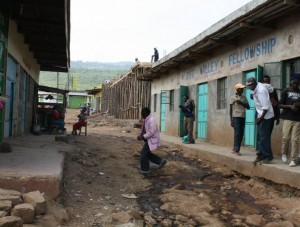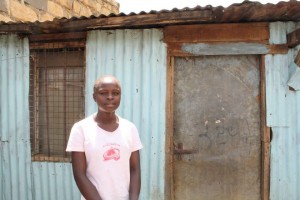I have just returned from Kenya, where David Dixon (a colleague of mine) and I took nine Malone students on a service-learning trip. Since David grew up in Kenya and I lived there for six years, it was like going home for us, in some respects.
This wasn’t exactly like a short-term missions trip because it was tied it to a class on the History of Christianity in East Africa. We emphasized learning more than most trips that churches sponsor. But it was similar in several respects: we visited a number of African ministries, we participated in service activities, and we were there for a limited time.
I have seen many dimensions to the diverse nation that is Kenya, including the dimensions that include deep poverty. So it wasn’t much of a stretch for me when, on our second full day, my Kikuyu friends, Isaac and Esther Munji, took our group down to visit a new church they had planted in a poor town called Maai Mahiu. Twenty years ago the town consisted of a gas station, a half dozen shops, a few homes and an orphanage. Today Maai Mahiu is like the Wild West. Situated along the primary highway that runs through East Africa, the town is pretty much a huge truck stop. 5000 people live in a place that is full of, among others, eager shopkeepers, truckers, prostitutes, homeless streetboys, orphans — in other words, a lot of people who have lost their ties to families and communities. It is estimated that about 90% of the people in this town are HIV positive.
If you have traveled to economically-deprived locations outside of the United States, you can probably imagine what our students faced: dirt streets with fetid water trickling through them, children scampering about in ragged clothes, trash scattered here and there, and a rather powerful cocktail of not-altogether pleasant smells.
We arrived at the church, Rift Valley Fellowship, and met a small gathering of about a dozen women and teenage girls. Isaac had everyone introduce themselves. Then we split up into two groups to walk to the houses of these women and pray for them. So I set off with a group and ended up with about ten of us crowded into a one-room home.
Again, this was not new to me. I have visited some pretty poor dwellings in Kenya before. I have prayed in homes with Kenyans. I’ve walked through some poor neighborhoods.
So why did I find myself crying as we prayed?
It is the face-to-face factor. The reality of a situation just has a way of hitting a person much deeper if it is witnessed face-to-face, as opposed to reading about it, or watching it on TV, or hearing somebody talk about it. We can know things in our head, but most of the time they don’t move us to action like the face-to-face factor does.
Several realities of this face-to-face encounter hit me at once: the difficult poverty of these women, the recognition that prostitution is one of the few options for generating income for women in this town, the personal dimension of meeting, talking to and learning names of people in this town, the thankfulness these women expressed that someone would care enough about them to come pray for them in their home, my recognition that our students were at that moment getting overwhelmed by all of this, and a deep sense of gratitude that our students still dove into this overwhelming cross-cultural situation, earnestly praying for these women.
The problem of describing this in a blog is that it is difficult to transfer the power of these
realities to those who have not had the face-to-face experience. I can give you a glimpse, but I cannot fully recapture the reality of that moment in this limited medium. I have known this for many years. There have been times during the past two decades that Elisa and I have joked that we just need to take certain people to Kenya so that they can understand things better. And there are more numerous times when I have been in need being transported myself.
The face-to-face factor is something to ponder carefully. It is one reason why I believe that the best online classes, though often helpful and necessary, will never be able to match the benefit of a good in-class experience. It is why we need to spend time with our kids and cannot hope to raise them as effectively from afar or in snippets. It is tied to the mystery of intimacy, as Philip Yancey points out, for human beings are the only species of animal that commonly has sex face to face. The face-to-face factor is why we cannot be lone wolf Christians, but must worship, fellowship and pray with others in church.
And the face-to-face factor may serve as the biggest benefit derived from short-term missions trips. There is a debate within some segments of the American evangelical community about the value of short term missions. There are good questions to consider in this debate, which I may discuss later. For now, let me say that I have talked to missionaries and local Christian leaders who say that the face-to-face impact of these trips is a major benefit, for it often spurs Americans to further action. It connects people across cultural and national boundaries. And it provokes deeper questions about Christ’s calling for our lives.
I don’t know of any systematic studies that have tried to gauge the impact of the face-to-face factor in short-term missions, though maybe they are out there. I do know that a trip to Haiti in 1969 had a big impact on my parents. (How many times did we view slides of Haiti in our living room with visiting friends and family? About eleventy-bajillion, to my 2nd grade way of thinking). A short-term trip to the Bahamas when I was in college played a major role in my life decisions.
The Bible speaks a number of times about face-to-face encounters. Usually it refers to the bright hope of seeing God face to face some day. I can’t begin to plumb the depths of meaning to this idea, but it does suggest that knowing and being known are more than simply mental processes. Now we see through a mirror dimly, then we will see face to face.
For a glimpse into the impact of the face-to-face factor on our Malone students, you can check out their final Kenya blog here.


